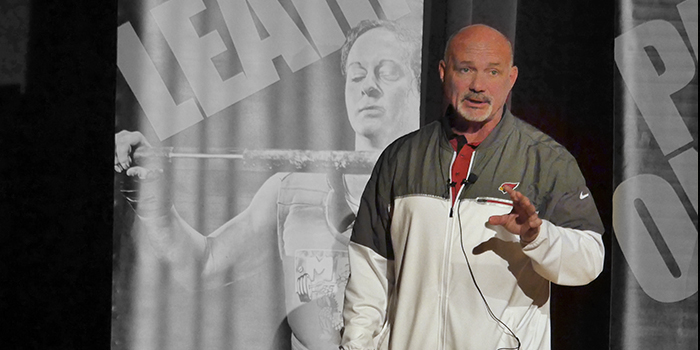
As we move to the fourth and final part of Buddy Morris' 2017 SPS Presentation, let's review the key information from the first three videos:
- Part One: Genetics and the environment are two factors that will influence everything you do in life.
- Part Two: As you continue to learn more about training, focus on developing the ability to identify gurus and gimmicks. This will save you years of time and hundreds of mistakes.
- Part Three: The brain controls everything. Your training program and the on-the-fly adjustments you make to that program should always account for the control of the brain.
In this final part of the presentation, Buddy begins by sharing the mission statement of his strength and conditioning program with the Arizona Cardinals:
"It is our responsibility to help our athletes achieve the highest level of physical preparation using methods/means that yield the highest possible results at the lowest cost."
The important part of this mission statement is the idea of risk/reward, Buddy says. If there's an incredibly effective exercise that also carries a big risk of injury, Buddy won't use it. To demonstrate this point, Buddy discusses Olympic lifting and explains why he doesn't use it.
WATCH: Buddy Morris SPS Presentation — The Brain Controls Everything
Buddy then talks about the purpose of training and physical preparation, pointing out three major goals:
- Increase the biological output of the organism or system.
- Increase the force of power output of the competitive exercise activity or movement.
- Always constantly improve the work capacity and best performance of the specific task.
Discussing each of these concepts, Buddy goes into detail about the inevitable imperfection of a training program. You can never design a perfect training program — and if you could, by the time you finished writing it, it would no longer be perfect. The body's state and needs are constantly changing. What got you to a 300-pound bench is not what's going to get you to a 400-pound bench.
Buddy then talks about the challenges of training NFL players under the current collective bargaining agreement, and how league regulations increase the difficulty of adequately preparing players for the rigors of the season. Many of these challenges are faced by strength and conditioning coaches at all levels and sports, and Buddy discusses the most important aspects of helping your athletes.
The final topic in Buddy's presentation is recovery. He discusses the body's needs for recovery, as well as the most important methods of preparing for the next training session. He details aspects of the recovery-adaptation process and explains the body's mechanisms for dealing with stress.
By the minute:
- (0:31) The Arizona Cardinal's Strength and Conditioning Mission Statement
- (4:12) Philosophies are for philosophers; systems are for coaches
- (8:10) Theme days in college strength programs
- (9:32) Increasing the force of power output, always improving work capacity
- (12:50) The benefits of training in dry heat
- (15:02) Training, by nature, is incomplete
- (22:06) Why Buddy no longer believe in periodization
- (27:50) The stress of life
- (33:27) Means of recovery
- (35:51) Aspects of the recovery-adaptation process










Are the slides used in his presentation available to view anywhere? Thanks again!